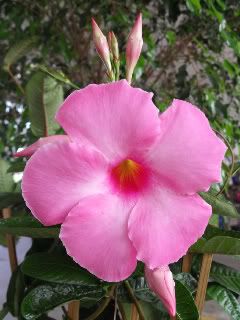Mandevilla Vine

Many people grow Mandevillas outdoors in pots, which makes them very easy to bring indoors at the end of warm weather. Keeping your plant in a pot through the year instead of planting it in the ground will make it easier to move when the time comes. Also, use a pot made of a light material (such as resin) as Mandevillas need relatively large pots and you don’t want it to be too heavy to move. Mandevillas are only hardy to USDA Zone 9; if you are outside of that and want your plant to survive the winter, it’s good to plan ahead.
 Once you’ve got your plant inside you will want to put it in the sunniest area possible. If you live near the equator, you may need to provide some protection from the midday sun with a sheer curtain. In the winter it is unlikely that you will be able to provide too much sun, and you may even want to provide additional light if possible.
Once you’ve got your plant inside you will want to put it in the sunniest area possible. If you live near the equator, you may need to provide some protection from the midday sun with a sheer curtain. In the winter it is unlikely that you will be able to provide too much sun, and you may even want to provide additional light if possible.
Mandevillas need a potting mix that has good drainage and yet retains moisture well. You’ll want to keep the potting mix from ever drying out all the way. Keep the mix evenly moist, but never sitting in water for long periods of time. It is okay to let the pot sit in water for an hour or so wick up moisture that may have escaped the plant during watering, just be sure to pour off any remaining water after that.
You’ll need to prune your Mandevilla vine yearly in the spring, preferably before new growth begins to appear. Cut the plant back to within and inch or two of the woody growth from the year before. This will send out a wonderful flush of new growth which will support the fresh new flowers.
Re-potting should also be done in the spring, probably near to or at the same time as pruning. If the plant has outgrown its pot, you can pot it up to the next pot size. If you don’t need to re-pot, simply top-dress the potting mix.
Mandevillas can be a magnet for pests. Keep an eye out for all of the most common houseplant pests: whitefly, mealybugs, spider mites, scale and aphids. It is especially important to check plants that have spent time outdoors. Plants that have been outside may even end up with insects living in their pots. Those bugs will not always be damaging to the plant itself but will most likely be unwelcome in your house.

Mandevillas need a potting mix that has good drainage and yet retains moisture well. You’ll want to keep the potting mix from ever drying out all the way. Keep the mix evenly moist, but never sitting in water for long periods of time. It is okay to let the pot sit in water for an hour or so wick up moisture that may have escaped the plant during watering, just be sure to pour off any remaining water after that.
You’ll need to prune your Mandevilla vine yearly in the spring, preferably before new growth begins to appear. Cut the plant back to within and inch or two of the woody growth from the year before. This will send out a wonderful flush of new growth which will support the fresh new flowers.
Re-potting should also be done in the spring, probably near to or at the same time as pruning. If the plant has outgrown its pot, you can pot it up to the next pot size. If you don’t need to re-pot, simply top-dress the potting mix.
Mandevillas can be a magnet for pests. Keep an eye out for all of the most common houseplant pests: whitefly, mealybugs, spider mites, scale and aphids. It is especially important to check plants that have spent time outdoors. Plants that have been outside may even end up with insects living in their pots. Those bugs will not always be damaging to the plant itself but will most likely be unwelcome in your house.
This site needs an editor - click to learn more!
You Should Also Read:
Madagascar Jasmine
Passion Flower
Houseplants Newsletter 
Related Articles
Editor's Picks Articles
Top Ten Articles
Previous Features
Site Map
Content copyright © 2023 by Lisa Beth Voldeck. All rights reserved.
This content was written by Lisa Beth Voldeck. If you wish to use this content in any manner, you need written permission. Contact
BellaOnline Administration
for details.


